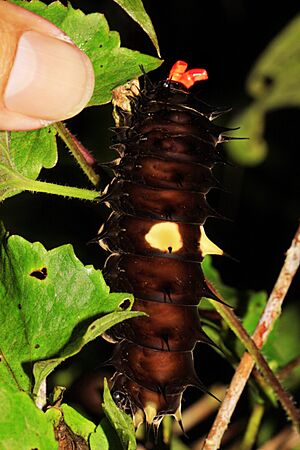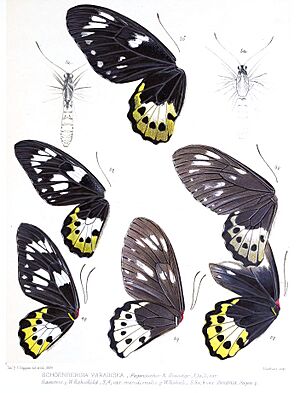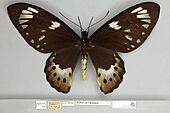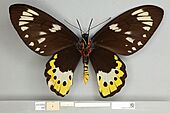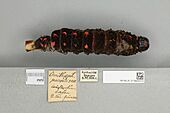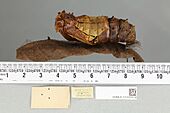Paradise birdwing facts for kids
Quick facts for kids Paradise birdwing |
|
|---|---|
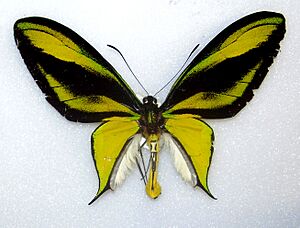 |
|
| Ornithoptera paradisea, male, top view | |
 |
|
| Ornithoptera paradisea, female, top view | |
| Conservation status | |
| Scientific classification |
The paradise birdwing (Ornithoptera paradisea) is a beautiful and large butterfly. It belongs to a group called birdwing butterflies. You can find this special butterfly in New Guinea. It's known for its bright colors and unique wing shapes.
Contents
History of Discovery
This amazing butterfly was first described in 1893. Two scientists, Arnold Pagenstecher and Otto Staudinger, both worked on describing it. Staudinger was the first to officially name it Ornithoptera paradisea. The name paradisea comes from a Persian word meaning "paradise." This name fits well because the butterfly looks so stunning!
The first specimens of this butterfly came from a collection in Germany. They were brought there from what was then called German New Guinea. The main specimen used for its description is now kept in a museum in Munich, Germany.
Description of the Paradise Birdwing
The paradise birdwing is a very large butterfly. Its wings can spread out from about 140 mm to 190 mm wide. That's like the length of a big smartphone!
Male and female paradise birdwings look quite different. This is called sexual dimorphism. They have different sizes, shapes, and colors on their wings.
Male Paradise Birdwing
Male paradise birdwings have black front wings. These wings have two large, bright bands of yellow-gold and green. The underside of their front wings is green with black lines.
Their back wings are small and shaped like triangles. They are golden with thin tails. There's often a green stripe between the golden part and the inner edge of the wing. The outer edge is usually green. The underside looks very similar to the top.
The male's body is yellow. Its head and chest area are black and green.
Female Paradise Birdwing
Female paradise birdwings are much larger than the males. Their main color is dark brown. On their front wings, they have two groups of white spots. Their back wings have a large white area with a yellow edge. Inside this white area, there's a line of black spots.
The underside of the female's wings looks very similar to the top. However, the colors are even brighter. Like the males, their body is yellow, and their head and chest are black and green.
Biology and Life Cycle
Paradise birdwings live in lowland or mountain forests. These are usually untouched forests. Adult male butterflies fly high up around trees. They rarely come down to the ground.
Female butterflies fly lower, under the trees. They search for a special plant called Aristolochia. This plant is what their caterpillars eat. The male butterfly gives off a nice smell from white hairs on its back wings. This smell helps attract females.
Life Stages
The life cycle of the paradise birdwing starts with an egg.
- Egg: The egg is about 4 mm wide and light orange. Females lay single eggs. They usually place them on the underside of an Aristolochia leaf.
- Caterpillar: When the egg hatches, the tiny caterpillar is dark red. As it grows, it becomes velvet black. It has red bumps with long black tips.
- Pupa: The caterpillar then turns into a pupa. The pupa is brown with a bright yellow and orange mark. It has a waxy coating and two short, sharp bumps on its body.
Challenges for Young Butterflies
Other insects sometimes lay their eggs inside the paradise birdwing eggs. This harms the developing butterfly. Caterpillars can also be attacked by tiny wasps. Ants, lizards, and birds also like to eat the caterpillars and pupae. During the rainy season, many caterpillars can die.
The paradise birdwing is closely related to another butterfly called Ornithoptera meridionalis.
Subspecies
A subspecies is a group of animals within a species that looks a bit different. They usually live in different areas. The paradise birdwing has several subspecies. Some of these are:
- Ornithoptera paradisea paradisea: This was the first subspecies found. It lived in lowland areas but is now extinct.
- Ornithoptera paradisea borchi: This subspecies lives in the central mountains of New Guinea. Its males have slightly different patterns.
- Ornithoptera paradisea arfakensis: This one lives in the high mountains of the Arfak Mountains. Some scientists even think it might be its own separate species.
Conservation Efforts
The paradise birdwing is a protected species. It is listed on CITES Appendix II. This means that you need a special permit to trade or move these butterflies across countries. This rule helps control how many are taken from the wild.
Some groups, like the World Association of Zoos and Aquariums, support local farmers in New Guinea. These farmers can earn money by raising butterflies for zoos. They also grow the plants that butterflies need to live. This helps protect the natural butterfly populations. Selling butterflies to collectors, when done correctly, can also help protect them. It gives people a reason to care for the butterflies and their homes.
Gallery
- Selection of museum specimens of Ornithoptera paradisea




